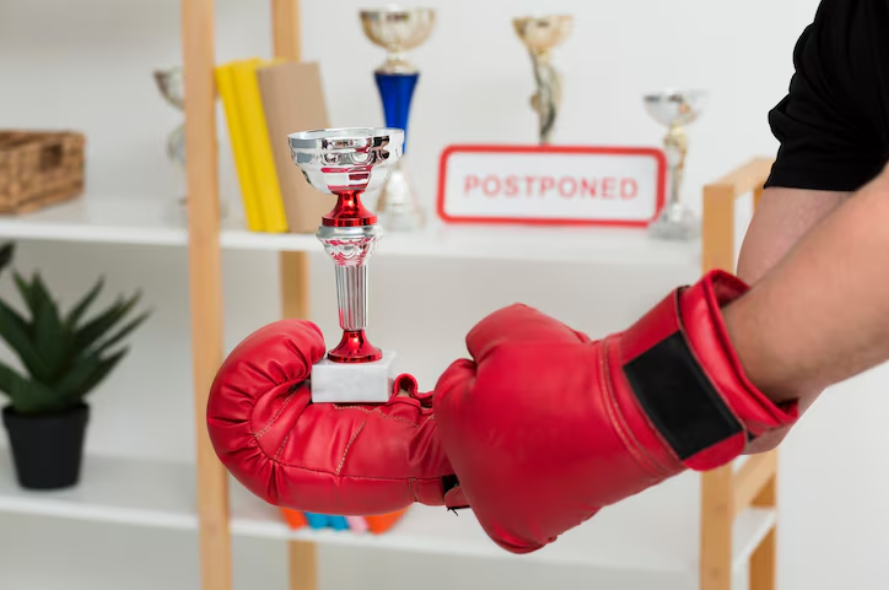Blog
Muay Thai Gloves: Everything You Need to Know Before Buying

Muay Thai Gloves, often referred to as the “Art of Eight Limbs,” is a powerful and technical combat sport that involves punches, kicks, elbows, and knees. Whether you’re a beginner starting your journey or an advanced fighter preparing for your next bout, one piece of equipment you simply cannot overlook is a quality pair of Muay Thai gloves. These gloves are not only essential for protection, but they also impact your training performance, technique, and long-term development.
This comprehensive guide walks you through every essential aspect of Muay Thai gloves, from types and materials to sizing and maintenance. Whether you’re buying your first pair or replacing a worn-out favorite, this guide will help you make an informed decision.
Why Muay Thai Gloves Are Different from Boxing Gloves
While Muay Thai and boxing gloves might look similar at a glance, their construction and design differ to cater to the unique demands of Muay Thai. Traditional boxing gloves are designed mainly for punching, focusing on wrist support and knuckle protection. Muay Thai gloves, on the other hand, are crafted to accommodate clinching, grabbing, and blocking kicks.
They often have more flexible wrist areas and more evenly distributed padding around the glove. This allows fighters to parry, grip, and maneuver effectively during clinch work, which is a fundamental part of Muay Thai. When choosing gloves, it’s crucial to ensure they’re purpose-built for Muay Thai and not just general boxing use.
Types of Muay Thai Gloves
There are different types of gloves depending on their intended use. Selecting the right type ensures better safety and improved performance during training or fights.
1. Training Gloves:
These are versatile gloves suitable for everyday use. They offer balanced padding and can be used for bag work, pad work, and light sparring.
2. Sparring Gloves:
Heavily padded gloves (typically 14oz to 16oz) designed to protect both you and your partner during sparring. They offer extra cushioning around the knuckles and wrist.
3. Bag Gloves:
These gloves are made for intense bag or pad work. They have denser foam padding for impact absorption but may not be suitable for sparring due to their hardness.
4. Fight Gloves:
Lightweight gloves (usually 8oz to 10oz) used in professional or amateur matches. They offer less padding for a more compact strike but must comply with fight regulations.
Glove Weights and Their Uses
Gloves are typically categorized by weight, measured in ounces (oz). The weight affects both protection and performance.
- 8oz–10oz: Common for competition use. Light and fast, but not ideal for regular training or sparring.
- 12oz: Ideal for lighter training or pad work. May be used by lighter fighters during technical sparring.
- 14oz: Standard size for most sparring and general training. Offers a balance between weight and protection.
- 16oz: Heavily padded, commonly used for full-contact sparring. Recommended for heavier fighters or those wanting extra protection.
For beginners, starting with a 14oz or 16oz glove is often the safest choice, depending on your weight and gym requirements.
Materials: Leather vs Synthetic
The material of a Muay Thai glove affects its durability, feel, and price.
Genuine Leather Gloves:
These are made from cowhide or buffalo leather. They offer superior durability, breathability, and mold to your hand over time. Leather gloves are preferred by professionals and long-term practitioners but are also more expensive.
Synthetic Leather (PU or PVC):
These are more affordable and often suitable for beginners or casual users. While not as durable as real leather, advances in synthetic materials have improved quality over the years. They’re also easier to clean and more water-resistant.
When investing in gloves, consider how often you’ll train. If you’re training multiple times a week, leather is a better long-term investment.
Velcro vs. Lace-Up Closure
The glove’s closure system influences both fit and convenience.
Velcro Gloves:
Ideal for training and general use. Easy to wear and remove without help. Velcro gloves are convenient for gym environments and self-training. However, the straps can wear down over time, affecting wrist support.
Lace-Up Gloves:
Provide a tighter, more customized fit and better wrist support. Commonly used in professional fights or by advanced practitioners. However, they require assistance to tie properly and are less practical for daily use.
If you’re training at a gym without regular assistance, Velcro gloves are more practical. For fight prep or dedicated sparring, lace-up gloves may offer added performance.
How to Choose the Right Glove Size
Selecting the correct glove size depends on your body weight, hand size, and intended use. While glove weight (in oz) indicates padding, proper fit is essential for safety and comfort.
General Size Guide by Body Weight:
- Under 120 lbs (55 kg) – 10oz to 12oz
- 120–150 lbs (55–68 kg) – 12oz to 14oz
- 150–180 lbs (68–82 kg) – 14oz to 16oz
- Over 180 lbs (82+ kg) – 16oz+
For sparring, always size up to protect your partner. Try gloves on with hand wraps to ensure a snug but not overly tight fit.
Hand Wraps: An Essential Companion
Never use gloves without hand wraps. Wraps protect your wrist, knuckles, and tendons by stabilizing the entire hand structure. They also absorb sweat, extending the life of your gloves. Wrap your hands correctly before wearing gloves and make it a habit.
There are various styles of wraps—traditional cotton wraps, gel wraps, or elastic wraps. Most practitioners prefer traditional cotton wraps for their adjustability and comfort.
Top Muay Thai Gloves Brands to Consider
Some brands specialize in Muay Thai gear and have earned a reputation for quality. Here are a few:
- Fairtex: Premium Thai brand known for durability and professional-grade equipment.
- Twins Special: A favorite for sparring gloves, widely used in Thailand gyms.
- Top King: Offers excellent wrist protection and well-padded gloves.
- Yokkao: High-end gloves with stylish designs, suited for both training and fighting.
- Venum: International brand with stylish, synthetic options. Suitable for all levels.
Always buy from reputable retailers and avoid counterfeits, which may look good but compromise on safety and quality.
Maintenance Tips for Long-Lasting Gloves
Proper maintenance can significantly extend the life of your gloves.
- Air them out after use: Never leave sweaty gloves in your gym bag. Open them up and allow them to dry completely.
- Use glove deodorizers: Products like cedar inserts or charcoal pouches help absorb moisture and reduce odor.
- Clean the interior: Occasionally use anti-bacterial sprays or gentle wipes to clean the inside lining.
- Avoid direct sunlight: Let gloves air dry naturally. Harsh heat or sun can damage the leather or stitching.
- Rotate gloves if possible: If you train frequently, owning two pairs and rotating them reduces wear and allows proper drying time.
Taking care of your gloves not only saves money but keeps your hands safe during training.
Common Mistakes to Avoid When Buying Gloves
- Buying boxing gloves for Muay Thai: As discussed earlier, they’re not the same. Always look for gloves specifically made for Muay Thai.
- Choosing the wrong size: Gloves too tight can restrict circulation; too loose can result in injury.
- Neglecting hand wraps: Gloves alone do not offer enough protection. Wraps are non-negotiable.
- Ignoring gym rules: Some gyms have strict requirements for sparring glove weight—check with your coach.
- Prioritizing design over quality: A flashy glove might look good but could compromise safety if poorly constructed.
Function always comes before form in combat sports.
Muay Thai Glove Pricing Guide
Price varies depending on brand, material, and quality.
- Budget Range ($20–$40): Usually synthetic gloves for beginners. Decent for light training or cardio kickboxing.
- Mid-Range ($40–$80): Offers better padding and durability. Suitable for regular training.
- Premium Range ($80–$150+): Made from genuine leather with advanced features. Built for intense training and competition.
It’s often worth investing in a quality pair once you’re committed to regular training. Poor gloves can lead to hand injuries and slow down progress.
Travel and Gym Considerations

If you travel for training or switch gyms often, consider the weight and bulk of your gloves. Compact gloves or those with carrying pouches are easier to transport. Also, keep an extra pair for gym-specific activities like clinching-only sessions or bag work.
Always label your gloves or keep them in a separate pouch—mix-ups in busy gyms are common.
Sustainability and Ethical Concerns
As more athletes become conscious of sustainability, some brands have started offering vegan-friendly and eco-conscious gloves. These gloves use synthetic leather alternatives without sacrificing quality. If environmental ethics are important to you, check the manufacturer’s sourcing policies and materials before purchasing.
Conclusion
Choosing the right Muay Thai gloves is about more than just color or style—it’s a decision that affects your safety, technique, and overall progress in the sport. Whether you’re a beginner learning to throw your first jab or a seasoned Nak Muay preparing for your next fight, the right pair of gloves provides protection, comfort, and confidence.
-

 Tech12 months ago
Tech12 months agoHow to Use a Temporary Number for WhatsApp
-

 Business2 years ago
Business2 years agoSepatuindonesia.com | Best Online Store in Indonesia
-

 Social Media1 year ago
Social Media1 year agoThe Best Methods to Download TikTok Videos Using SnapTik
-

 Technology1 year ago
Technology1 year agoTop High Paying Affiliate Programs
-

 Tech7 months ago
Tech7 months agoUnderstanding thejavasea.me Leaks Aio-TLP: A Comprehensive Guide
-

 Instagram3 years ago
Instagram3 years agoFree Instagram Auto Follower Without Login
-

 Instagram3 years ago
Instagram3 years agoFree Instagram Follower Without Login
-

 Technology11 months ago
Technology11 months agoLeverage Background Removal Tools to Create Eye-catching Videos


















